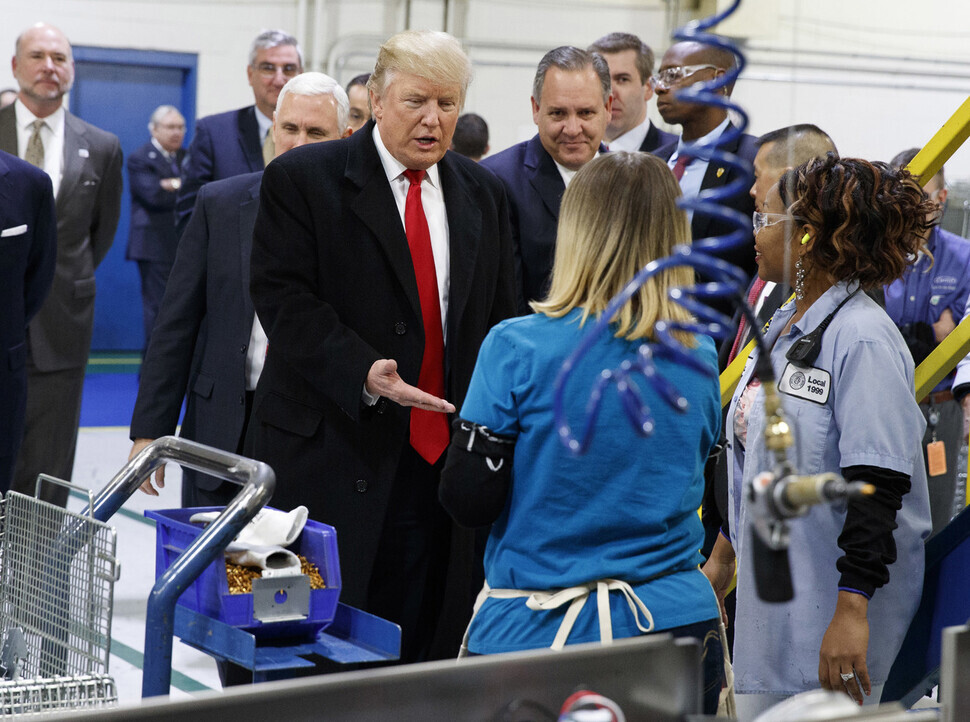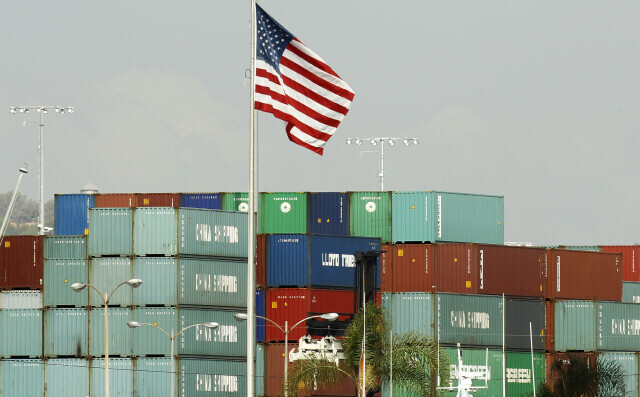hankyoreh
Links to other country sites 다른 나라 사이트 링크
How “America First” cost the world and fomented uncertainty across the globe

Editor’s note: The leader of South Korea’s main opposition party went on a hunger strike, a motion consenting to his arrest was passed by the National Assembly, which led to a protest by his supporters, and a warrant for his arrest was requested and then subsequently rejected. The intense political confrontation currently unfolding in Korea is not unusual, however. Even in the United States, which has long portrayed itself as a bastion of democracy, the Capitol was overtaken by rioters three years ago, and a former president is now under indictment. We are witnessing the rise of a climate where political opponents are increasingly seen as “enemies.” This crisis of democracy, intertwined with challenges like a struggle for global hegemony, wars, and inflation, is exacerbating public unease. In light of these developments, the Hankyoreh is publishing a series of articles in anticipation of the Asia Future Forum, which will be held on Wednesday, Oct. 11. The pieces in this series will delve into the root causes of these crises and explore potential solutions, in line with the forum’s theme: “The Age of the Polycrisis: A Way to Coexistence.”
In 1979, Tony Michael left the Soviet Union in search of freedom, arriving in the US with dental equipment in tow. Today, the very hammer he brought with him back then, alongside timeworn crowns and dental prosthetics, sits on display in his office located on the outskirts of Chicago. However, the dental lab that he manages with two other partners is not thriving as it once did. Struggling to adapt to the advancements in digital technology, their competitive edge has waned. Yet, for Michael, an even greater challenge has emerged from China. His lab produces dental crowns, selling them to local dental practices for US$200 apiece. However, Chinese equivalents fetch a mere US$30 and can be air-shipped within a week.
The US dental market, estimated to be worth approximately US$13 billion, continues to grow each year. However, the number of dental labs is on the decline due to aging owners, the allure of retirement, and the surge of affordable Chinese imports.
Michael's personal journey is but a microcosm of a larger narrative faced by countless manufacturing workers in the Rust Belt — a region in the US Midwest grappling with immense technological developments and the influence of China. These challenges stem from the expansion of free trade under the guise of globalization. Between 2000 and 2010, manufacturing employment in six Rust Belt states plummeted by 35%, a decrease sharper than during the Great Depression. A quarter of this job loss was estimated to be due to the “China effect.”
Although new jobs have emerged, many lack stability or offer low wages. For the white working class of the Rust Belt, dubbed the “left behind,” Donald Trump's “America First” approach resonated deeply. Trump vowed to restore jobs and dignity to this beleaguered community, a promise that undoubtedly played a pivotal role in his 2016 presidential triumph.
According to John Austin, a non-resident senior fellow at the Brookings Institution in the US, the Rust Belt is a region defined by a large segment of its population that feels alienated and marginalized due to geopolitical factors. He noted that this provides fertile ground for populist leaders and amplifies sentiments of nationalism, isolationism, and economic nostalgia, which fuels political polarization and damages Western democracy. Trump, it seems, knew precisely where to plant his seeds.

To Trump’s supporters, “America First” felt as refreshing as an ice-cold soda on a hot day. Take Aaron, an economics graduate now employed at a Milwaukee insurance firm, who encapsulates this sentiment. According to him, US politics have sidelined Americans for the better part of a century. But Trump changed that, he said, adding that Trump championed American interests and workers, not just in words, but with tangible policy actions.
To safeguard American interests and jobs, Trump set his sights on China. The US had long reaped the benefits of incorporating the East Asian giant into the global supply chain as a base for subcontracting. However, as China grew in stature, it became a perceived “threat” to US dominance. In 2018, as Trump levied a 25% tariff on Chinese goods, China retaliated in kind. This tit-for-tat escalated into a trade dispute that sent anxious ripples across the global trade landscape.
The roots of America First can be traced back to the Buy American Act signed by President Herbert Hoover on his last day in office in 1933. This act was a protectionist measure that prioritized the purchase of American-made products by the government. Thus, while the America First sentiment was not a novel concept, it took on a sharper focus under Trump, particularly in the realms of trade and international relations, in a bid to resonate with white working-class voters. However, what came as a surprise to many was current President Joe Biden's decision to expand and deepen Trump’s America First approach, even though he was initially expected to diverge from his predecessor’s policies.
“The Biden administration has maintained and even strengthened policies such as prioritizing the purchase of American-made products, protectionism, and pressuring China in trade since taking office,” explained Park Bok-yeong, a professor at Kyung Hee University’s Graduate School of Pan-Pacific International Studies. “While Trump’s policies were limited to trade pressures against China, Biden’s approach toward China is a combination of trade pressure (protectionism) and values-based diplomacy (raising issues like human rights in Hong Kong and the Taiwan issue), intensifying both strategic and ideological competition.”
To do so, Biden employed tools like the Inflation Reduction Act (IRA) and the CHIPS and Science Act. This is a strategy of encouraging companies to build factories in the US, creating manufacturing jobs while simultaneously blocking challenges from China.

While these moves have had significant political effects in the US domestically, their actual economic impact remains unverified. Globally, they have led to considerable confusion and cost.
“Policies designed to curb inflation and stimulate the economy often ironically produce the opposite result,” commented Oh Town, a professor at DePauw University in the US. “Protectionism can lead to rising prices, declining product quality, and disruptions in the supply chain.”
Yet, there is an undeniable political rationale behind both Trump and Biden bolstering protectionist measures while using the safeguarding of manufacturing jobs as justification. Park explained, “It is largely a response to the rising unemployment and growing discontent among the US’s white working class. Their votes in the several most recent presidential elections have indeed been crucial.”
America First has intensified US-China trade disputes and, coupled with the COVID-19 pandemic, has accelerated the restructuring of global supply chains. With the added layer of Russia’s invasion of Ukraine, it has further fueled global inflation. Moreover, rising prices caused by these multi-layered crises and the raising of interest rates to tame them have heightened suffering and anxiety worldwide.
The America First strategy led to a butterfly effect that brought about these overlapping crises. The costs, however, are being borne by not just the US, but the entire world.
By Ryu Yi-geun, senior staff writer at the Hankyoreh Economy and Society Research Institute
Please direct questions or comments to [english@hani.co.kr]

Editorial・opinion
![[Column] Will Seoul’s ties with Moscow really recover on their own? [Column] Will Seoul’s ties with Moscow really recover on their own?](https://flexible.img.hani.co.kr/flexible/normal/500/300/imgdb/original/2024/0513/5917155871573919.jpg) [Column] Will Seoul’s ties with Moscow really recover on their own?
[Column] Will Seoul’s ties with Moscow really recover on their own?![[Column] Samsung’s ‘lost decade’ and Lee Jae-yong’s mismatched chopsticks [Column] Samsung’s ‘lost decade’ and Lee Jae-yong’s mismatched chopsticks](https://flexible.img.hani.co.kr/flexible/normal/500/300/imgdb/original/2024/0512/3017154788490114.jpg) [Column] Samsung’s ‘lost decade’ and Lee Jae-yong’s mismatched chopsticks
[Column] Samsung’s ‘lost decade’ and Lee Jae-yong’s mismatched chopsticks- [Correspondent’s column] The real reason the US is worried about Chinese ‘overcapacity’
- [Editorial] Yoon’s gesture at communication only highlights his reluctance to change
- [Editorial] Perilous stakes of Trump’s rhetoric around US troop pullout from Korea
- [Guest essay] Preventing Korean Peninsula from becoming front line of new cold war
- [Column] The state is back — but is it in business?
- [Column] Life on our Trisolaris
- [Editorial] Penalties for airing allegations against Korea’s first lady endanger free press
- [Editorial] Yoon must halt procurement of SM-3 interceptor missiles
Most viewed articles
- 1Ado over Line stokes anti-Japanese sentiment in Korea, discontent among Naver employees
- 2[Column] Samsung’s ‘lost decade’ and Lee Jae-yong’s mismatched chopsticks
- 3Korean opposition decries Line affair as price of Yoon’s ‘degrading’ diplomacy toward Japan
- 4US has always pulled troops from Korea unilaterally — is Yoon prepared for it to happen again?
- 5Korean auto industry on edge after US hints at ban on Chinese tech in connected cars
- 6[Editorial] Yoon’s gesture at communication only highlights his reluctance to change
- 7[Correspondent’s column] The real reason the US is worried about Chinese ‘overcapacity’
- 8[Column] Will Seoul’s ties with Moscow really recover on their own?
- 9[Photo] Korean students protest US complicity in Israel’s war outside US Embassy
- 101 in 3 S. Korean security experts support nuclear armament, CSIS finds